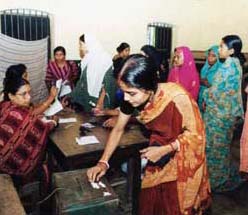 |
 Population & Health |
 |
| Population & Health | Democracy & Governance | Anti-Trafficking | Enterprise Development | Energy |
| Environment | Food Security | Disaster Management | Education | Gender |
Facts About Population
& Health
- Bangladesh is the 7th most populous country in the world.1
- The population is approximately 140 million in a land area of 55,598 square miles. Population density is 2,639 per square mile.1
- The annual population growth rate is 1.9%.1
1World Bank Development Indicators Database, April 2006.
Current Conditions: Population & Health
Dramatic Improvements in Health
Twenty years ago, many experts claimed the nation's conservative culture and low standard of living would be insurmountable obstacles to family planning and child survival programs in Bangladesh. However, over the past three decades health indicators have improved dramatically.Recent preliminary findings from the 2004 Bangladesh Demographic and Health Survey (BDHS) show that fertility has declined in Bangladesh after a decade long plateau. Overall, fertility has declined dramatically since the early 1970s from 6.3 children per woman to 3.4 in the early 1990s, remaining stable during most of the 1990s. The recent decline in fertility from 3.3 in 1999 to 3.0 in 2004 is modest but encouraging for policy makers and program managers. Contraceptive use continues to increase in Bangladesh with 58 percent of married couples now using a contraceptive method compared to 54 percent four years ago.
There has been a significant increase in use of antenatal care among pregnant women, from 33% in 2000 to 49% in 2004. Now, almost half of pregnant women receive at least one antenatal care visit from a trained health provider. Despite the rise in antenatal care, only one in four women receive three or more antenatal visits during her pregnancy, and a vast majority of women give birth without a trained birth attendant.
Over the last 3 decades, mortality rates of children under the age of five have declined due to reductions in both infant and child mortality. However, in recent years infant mortality has not changed due to stagnation of the neonatal death rate, which now accounts for two-thirds of all infant deaths. Reducing neonatal mortality has become an emerging challenge for Bangladesh.
Recent Plateaus Require Vigilance
Over the past several years, we have seen a plateau in key areas, calling attention to the imperative for continuous efforts. The number of children per woman of child-bearing age declined dramatically from the 1970s. However, it has remained stagnant around 3 for the past 10 years.Fewer than half the pregnant women in Bangladesh receive any prenatal care. Only about 20% have 3 or more prenatal visits. Over 90% of women deliver at home, the vast majority with no trained birth attendant. HIV/AIDS infection rate remains low in the general population. However, in certain high risk groups, the infection rate is rapidly reaching the threshold level. This could mean a full blown epidemic in the near future.